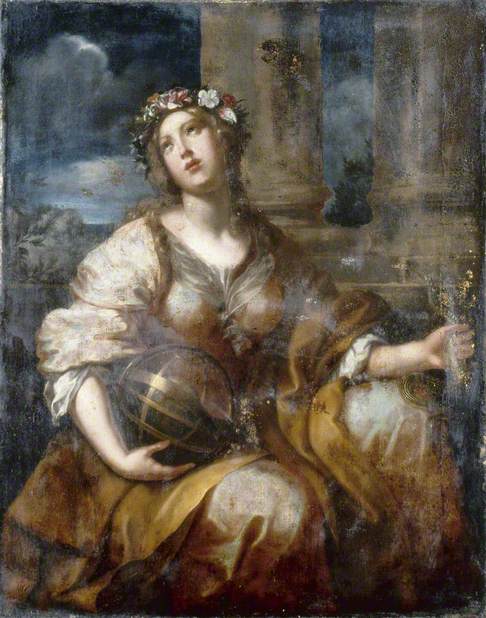Forward Continental European before 1800 12 comments Is this figure a personification of Intelligence?

Photo credit: Brighton & Hove Museums
Art UK: This question was raised by Alistair Brown, who died in February 2022. We will continue adding any of his submissions that might benefit from discussion.
'This is not Cleopatra – she does not appear to have been bitten and in no other representation of her does she wear a garland or hold a globe. The iconography seems to point to the figure being a personification of Intelligence. It may be derived from Cesare Ripa's ‘Iconologia’ (first illustrated edition 1603) – see image or from another source – see link to and earlier representation in the BM. The work looks to be 17th C Florentine – around Cesare Dandini.' https://bit.ly/3kLNQdO
Comment from the collection: ‘I am afraid that neither our history or conservation files reveal anything further about The Death of Cleopatra. The work is unframed so I was able to check the back, which was bare. There is loss on the surface of the painting but she does appear to be holding a snake or asp in her left hand.’
[Group leader: Xanthe Brooke/Andrew Greg]
12 comments
The motif of a woman holding a snake is common in allegorical depictions of Prudence, but the globe is harder to explain (a mirror is more typical). However, compare to the version below:
https://bit.ly/3vZSJVO
The globe could fit Urania, Muse of Astronomy, but not the snake.
A fully clothed Cleopatra at the time of her suicide would be unusual, and the globe does not fit her.
Has the painting been x-rayed?
Wild idea-Judith and Holofernes overpainted?
The combination of snake and globe (actually an armillary sphere) is indeed unusual. The snake is associated with Wisdom and Prudence (alternative members of the Four Virtues) from “Be ye wise as serpents” Mathhew 10:16. The globe, although not associated with a particular Virtue is, according to Hall’s Dictionary of Subjects and Symbols in Art, “widely distributed among personified virtues, the Liberal Arts and some pagan divinities, signifying their universality.”
The print linked to by Alistair Brown does indeed have an armillary sphere and a snake at her feet. ‘Intelliengentia’ is obviously linked to Prudence and Wisdom. This Allegory of Wisdom in the Met also as snakes and a globe. https://www.metmuseum.org/art/collection/search/380390
The snake has no role in the Liberal Art of Astronomy, so probably the balance is indeed that this represents the Virtue of Prudence/Wisdom, as Jacinto suggests in his example.
The relevant Dandini allegory is at https://bit.ly/3FheLYB
There is also this Flora by Pietro (as opposed to Cesare) Dandini with a similar garland and face:
https://bit.ly/3LRhAlp
I think "intelligence" is not the best term to use for this allegory, though the terminology could be discussed in a descriptive note in the Art UK entry. I would favor Allegory of Wisdom/Prudence.
I agree that it is something more allusive than Cleopatra.
The specific 'Liberal Art' is usually called 'Logic' rather than 'Intelligentia' and (as Hall puts it) 'Logic holds a SNAKE, sometimes two, or rests her hand on a nest of vipers....'. in this instance it is fairly clearly the first of these. Flowers -of which she wears a prominent chaplet - are also associated both with Logic (though usually held, or held as a flowering branch) and with Hope, while her skyward gaze is also an attitude symbolic of Hope.
Pillars are generally fortitude/constancy and as a pair were adopted (as the Pillars of Hercules) as an symbol of transatlantic empire by Charles V of Spain. The sea is in the distance here and (when calm) is sometimes associated with the mirror as a symbol of virtue/prudence albeit usually in a more religious context than here.
While armillary spheres are a symbol of the universe and of astronomy as one of the 'seven liberal arts', when connected with the latter they are usually found with other astronomical or navigational instruments, as here:
https://www.britishmuseum.org/collection/object/P_1880-0612-206
They also sometimes appear in early 17th century Dutch images as warship figurehead emblems, presumably also for aspiration to universal reach/empire through seapower/navigation.
In all -slightly disagreeing with Jacinto - it would perhaps be more appropriate to suggest this image is an 'Allegory of Logic', albeit with hints in other virtuous and universal directions.
The canvas is also large: possibly survivor of a set of the Seven Liberal Arts?
Here is an article about the donation by George Stringer in 1903.
A sibyl can be portrayed with a sphere https://bit.ly/3kMzAl1 but the snake doesn't fit.
This may be a conflation of one of the seven liberal arts, Astronomy, with a corresponding virtue, Prudence. A known example of that is a 1533 depiction of the Liberal Arts by Martin Schaffner https://bit.ly/3vT1HW0 where Astronomy is at the lower right corner, holding a snake, with an armillary sphere on the ground next to her (clicking on the image will enlarge it). Text related to this painting is at https://bit.ly/3Fmm3dw (scroll down to the image of the Schaffner painting; the explanatory text is below it). Thus, this may be part of a set of the seven Liberal Arts connected to Virtues.
I expect the Cesare Dandini allegorical figure linked above is also a conflation of Astronomy and Prudence, not an allegory of Intelligence. The compass she carries is frequently included, along with a globe or sphere, in depictions of Astronomy, as in https://bit.ly/3ysryWu
Allegories can be complex and open to more than one interpretation, but what seems clear is that this is not a Cleopatra, even though the picture was identified as such when it entered the collection.
